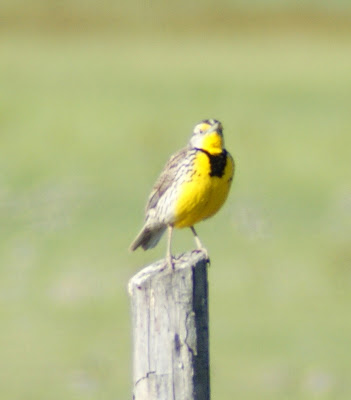Bear River Migratory Bird Refuge is a fantastic place to go birding. The facility is new, the auto tour is long, the birds are numerous... the only poor aspect is the presence of mosquitoes and brine flies that can sometimes create clouds of "smoke" along side the road. Or land in such numbers on your windshield that it's difficult to look out at the birds. (If the latter happens just a word of advice: DO NOT TRY TO USE YOUR WINDSHIELD WIPERS TO CLEAR THEM OFF! The little buggers are greasy and all you'll do is leave an opaque smudge across the glass.)
Speaking of blurred views...you should also check your camera's setting before you start to take pictures. I forgot and still had the camera set for landscape views when I snapped the first shots on the bird refuge. The result was less than perfect.
As loud as the Meadowlark's song was (and it was very, very loud) it couldn't compete with the Yellow-headed Blackbird.
More numerous and less melodious, the Yellow-headed Blackbird didn't just vie for attention with musical notes, he hit you over the head with the tuba...and the bass fiddle...and the kettle drum for good measure. While walking around near the refuge headquarters, I kept looking for the forklift that was tooting it's horn only to discover that it was the Yellow-headed Blackbird and not some runaway from Home Depot.
Much quieter than the two birds above but just as numerous as the Yellow-headed Blackbird was the American Avocet.
This long-legged wading bird was found in the flooded fields between the refuge headquarters and the refuge proper and in the shallows pools of the refuge. The bird in this photo is almost out of his depth. They wade, not swim. The long up-swept bill, the salmon coloring of the head, the black and white body made them impossible to misidentify.
Another wading bird that was present in abundance was the White-faced Ibis.
This bird is extremely similar to the Glossy Ibis but mature, breeding adults have a white outline around the eye and in the area where their bill meets their head. Both birds have a glossy multi-sheen black, red, green body color. Both have long black legs of a wading bird and both have very long bills for probing into the mud. Like most of the large wading birds, their flight is quite graceful as they glide in for a landing, stalling at the last minute and suspending themselves in the air momentarily before dropping their long, long legs straight down to touch down gently.
Swimming and diving water fowl also are abundant at the refuge. One of the most abundant divers--and among the most fun to watch--is the Western Grebe.
A large grebe with a very long, bi-colored (black and white) neck, the Western Grebe has a most regal appearance--until it's time to mate. The two identical birds swim side by side and quickly cock their heads at 45 degree angles to the left, back to center, to the right and back to center. Over and over again as they swim along. If things click, the two may rear up on their webbed feet and run across the water, flapping their wings as the go. We didn't get to see the latter behavior--this time, but there was enough head swinging to give me whiplash.
Well, there are five birds we saw at the refuge. I'll post more in just a little while.





No comments:
Post a Comment